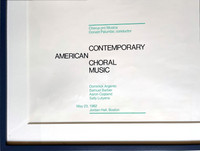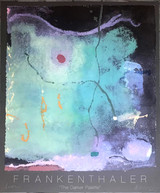
An Educated Collector is Our Best Client
In business for nearly two decades, we are a well established, popular contemporary art boutique specializing in expertly chosen, blue chip prints, multiples, uniques, books, ephemera and merchandise at different price points, with a focus on the secondary market. Please click on the "Contact Us" button at the bottom of this page for questions about any work, pricing and/or to arrange to visit our showroom/gallery - located in between Manhattan's Flatiron and Chelsea Flower Districts.
Helen Frankenthaler, Contemporary American Choral Music (Hand signed by both Helen Frankenthaler and Aaron Copland), 1982
CONTACT GALLERY FOR PRICE
Description
Helen Frankenthaler
Contemporary American Choral Music (Hand signed by both Helen Frankenthaler and Aaron Copland), 1982
Offset lithograph poster (Hand signed by Helen Frankenthaler and Aaron Copland)
Hand signed by Helen Frankenthaler and Aaron Copland on the front
Frame included
This offset lithograph was published exclusively on the occasion of Chorus Pro Musica's concert Contemporary American Choral Music held on May 23, 1982 in Boston. The artwork depicted in this poster is Untitled, 1981, by Helen Frankenthaler.
This print is, exceptionally hand signed by Helen Frankenthaler and Aaron Copland on the front. The total edition number is unknown, but only a small few of them were hand signed by both Frankenthaler and Copland.
A wonderful collectors item!
Measurements:
Frame:
30 x 26.75 x 2 inches
Print:
25.25 x 21.75 inches
About Helen Frankenthaler:
A line, color, shapes, spaces, all do one thing for and within themselves, and yet do something else, in relation to everything that is going on within the four sides [of the canvas]. A line is a line, but [also] is a color. . . . It does this here, but that there. The canvas surface is flat and yet the space extends for miles. What a lie, what trickery—how beautiful is the very idea of painting.
—Helen Frankenthaler
Helen Frankenthaler (1928–2011), whose career spanned six decades, has long been recognized as one of the great American artists of the twentieth century. A member of the second generation of postwar American abstract painters, she is widely credited with playing a pivotal role in the transition from Abstract Expressionism to Color Field painting. Through her invention of the soak-stain technique, she expanded the possibilities of abstraction, while at times referencing figuration and landscape in highly personal ways. She produced a body of work whose impact on contemporary art has been profound and continues to grow.
Frankenthaler was born on December 12, 1928, and raised in New York. She attended the Dalton School, where she received her earliest art instruction from Rufino Tamayo. In 1949 she graduated from Bennington College, Vermont, where she was a student of Paul Feeley, following which she studied briefly with Hans Hofmann.
Frankenthaler exhibited her work professionally for the first time in 1950, at the Kootz Gallery in New York, when Adolph Gottlieb selected her painting Beach (1950) for inclusion in Fifteen Unknowns: Selected by Artists of the Kootz Gallery. Her first solo exhibition was presented in 1951, at New York’s Tibor de Nagy Gallery, and that year she was also included in the landmark 9th St. Exhibition of Paintings and Sculpture in New York.
In 1952 Frankenthaler created Mountains and Sea, her breakthrough soak-stain painting. She poured thinned paint directly onto raw, unprimed canvas laid on the studio floor, working from all sides to create floating fields of translucent color. Mountains and Sea was immediately influential for the artists who formed the Color Field school of painting, notable among them Morris Louis and Kenneth Noland.
As early as 1959 Frankenthaler began to be a regular presence in major international exhibitions. That year she won first prize at the Première Biennale de Paris, and in 1966 she represented the United States at the 33rd Biennale di Venezia, alongside Ellsworth Kelly, Roy Lichtenstein, and Jules Olitski. She had her first museum retrospective in 1960, at New York’s Jewish Museum, and her second in 1969, at the Whitney Museum of American Art, New York, followed by an international tour. Additional museum retrospectives have been held at the Solomon R. Guggenheim Museum, New York, and touring venues (1985, works on paper); Modern Art Museum of Fort Worth, Texas, and touring venues, including Museum of Modern Art, New York (1989, paintings); National Gallery of Art, Washington, DC, and touring venues (1993, prints); Naples Museum of Art, Florida, and touring venues, including Yale University Art Gallery, New Haven, Connecticut (2002, woodcuts); and Museum of Contemporary Art, North Miami, Florida, and touring venue, Royal Scottish Academy, Edinburgh, Scotland (2003, works on paper).
Throughout her long career, Frankenthaler experimented continuously. In addition to paintings on canvas and paper, she worked in a wide range of mediums, including ceramics, sculpture, tapestry, and especially printmaking. Hers was a significant voice in the mid-century “print renaissance” among American abstract artists, and she is particularly known for her woodcuts, in which she layered numerous colors in a manner that expanded the possibilities of the medium.
In addition to numerous scholarly articles on her work by renowned art historians, curators, and critics, Frankenthaler has been the subject of three major monographs: Frankenthaler, by Barbara Rose (1972); Frankenthaler, by John Elderfield (1989); and Frankenthaler: A Catalogue Raisonné, Prints 1961–1994, by Suzanne Boorsch and Pegram Harrison (1996).
In 2015 Gagosian published “The heroine Paint”: After Frankenthaler, a book of essays edited by art historian and curator Katy Siegel that explores Frankenthaler’s painting and expands its focus to include the immediate social and artistic context of her work, then traces artistic currents as they move outward in different directions in the ensuing decades.
Frankenthaler was the recipient of numerous honorary doctorates, honors, and awards. She received the National Medal of Arts in 2001; served on the National Council on the Arts of the National Endowment for the Arts from 1985 to 1992; was a member of the American Academy of Arts and Letters from 1974 to 2011, serving as Vice-Chancellor in 1991; and was appointed an Honorary Academician of the Royal Academy of Arts, London, in 2011.
Important works by Frankenthaler are held in the collections of major museums worldwide.
Courtesy of Gagosian Gallery
About Aaron Copland:
Aaron Copland (November 14, 1900 – December 2, 1990) was an American composer, composition teacher, writer, and later a conductor of his own and other American music. Copland was referred to by his peers and critics as the "Dean of American Composers". The open, slowly changing harmonies in much of his music are typical of what many people consider to be the sound of American music, evoking the vast American landscape and pioneer spirit. He is best known for the works he wrote in the 1930s and 1940s in a deliberately accessible style often referred to as "populist" and which the composer labeled his "vernacular" style. Works in this vein include the ballets Appalachian Spring, Billy the Kid and Rodeo, his Fanfare for the Common Man and Third Symphony. In addition to his ballets and orchestral works, he produced music in many other genres, including chamber music, vocal works, opera and film scores.
After some initial studies with composer Rubin Goldmark, Copland traveled to Paris, where he first studied with Isidor Philipp and Paul Vidal, then with noted pedagogue Nadia Boulanger. He studied three years with Boulanger, whose eclectic approach to music inspired his own broad taste. Determined upon his return to the U.S. to make his way as a full-time composer, Copland gave lecture-recitals, wrote works on commission and did some teaching and writing. However, he found that composing orchestral music in the modernist style, which he had adopted while studying abroad, was a financially contradictory approach, particularly in light of the Great Depression. He shifted in the mid-1930s to a more accessible musical style which mirrored the German idea of Gebrauchsmusik ("music for use"), music that could serve utilitarian and artistic purposes. During the Depression years, he traveled extensively to Europe, Africa, and Mexico, formed an important friendship with Mexican composer Carlos Chávez and began composing his signature works.
During the late 1940s, Copland became aware that Stravinsky and other fellow composers had begun to study Arnold Schoenberg's use of twelve-tone (serial) techniques. After he had been exposed to the works of French composer Pierre Boulez, he incorporated serial techniques into his Piano Quartet (1950), Piano Fantasy (1957), Connotations for orchestra (1961) and Inscape for orchestra (1967). Unlike Schoenberg, Copland used his tone rows in much the same fashion as his tonal material—as sources for melodies and harmonies, rather than as complete statements in their own right, except for crucial events from a structural point of view. From the 1960s onward, Copland's activities turned more from composing to conducting. He became a frequent guest conductor of orchestras in the U.S. and the UK and made a series of recordings of his music, primarily for Columbia Records.

















